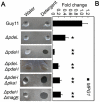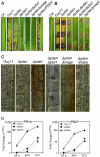Two phosphodiesterase genes, PDEL and PDEH, regulate development and pathogenicity by modulating intracellular cyclic AMP levels in Magnaporthe oryzae
- PMID: 21386978
- PMCID: PMC3046207
- DOI: 10.1371/journal.pone.0017241
Two phosphodiesterase genes, PDEL and PDEH, regulate development and pathogenicity by modulating intracellular cyclic AMP levels in Magnaporthe oryzae
Abstract
Cyclic AMP (cAMP) signaling plays an important role in regulating multiple cellular responses, such as growth, morphogenesis, and/or pathogenicity of eukaryotic organisms such as fungi. As a second messenger, cAMP is important in the activation of downstream effector molecules. The balance of intracellular cAMP levels depends on biosynthesis by adenylyl cyclases (ACs) and hydrolysis by cAMP phosphodiesterases (PDEases). The rice blast fungus Magnaporthe oryzae contains a high-affinity (PdeH/Pde2) and a low-affinity (PdeL/Pde1) PDEases, and a previous study showed that PdeH has a major role in asexual differentiation and pathogenicity. Here, we show that PdeL is required for asexual development and conidial morphology, and it also plays a minor role in regulating cAMP signaling. This is in contrast to PdeH whose mutation resulted in major defects in conidial morphology, cell wall integrity, and surface hydrophobicity, as well as a significant reduction in pathogenicity. Consistent with both PdeH and PdeL functioning in cAMP signaling, disruption of PDEH only partially rescued the mutant phenotype of ΔmagB and Δpka1. Further studies suggest that PdeH might function through a feedback mechanism to regulate the expression of pathogenicity factor Mpg1 during surface hydrophobicity and pathogenic development. Moreover, microarray data revealed new insights into the underlying cAMP regulatory mechanisms that may help to identify potential pathogenicity factors for the development of new disease management strategies.
Conflict of interest statement
Figures











Similar articles
-
PdeH, a high-affinity cAMP phosphodiesterase, is a key regulator of asexual and pathogenic differentiation in Magnaporthe oryzae.PLoS Pathog. 2010 May 6;6(5):e1000897. doi: 10.1371/journal.ppat.1000897. PLoS Pathog. 2010. PMID: 20463817 Free PMC article.
-
Phosphodiesterase MoPdeH targets MoMck1 of the conserved mitogen-activated protein (MAP) kinase signalling pathway to regulate cell wall integrity in rice blast fungus Magnaporthe oryzae.Mol Plant Pathol. 2016 Jun;17(5):654-68. doi: 10.1111/mpp.12317. Epub 2015 Dec 2. Mol Plant Pathol. 2016. PMID: 27193947 Free PMC article.
-
The high-affinity phosphodiesterase PdeH regulates development and aflatoxin biosynthesis in Aspergillus flavus.Fungal Genet Biol. 2017 Apr;101:7-19. doi: 10.1016/j.fgb.2017.02.004. Epub 2017 Feb 14. Fungal Genet Biol. 2017. PMID: 28212851
-
New findings on phosphodiesterases, MoPdeH and MoPdeL, in Magnaporthe oryzae revealed by structural analysis.Mol Plant Pathol. 2018 May;19(5):1061-1074. doi: 10.1111/mpp.12586. Epub 2017 Oct 17. Mol Plant Pathol. 2018. PMID: 28752677 Free PMC article.
-
Infection-related development in the rice blast fungus Magnaporthe grisea.Curr Opin Microbiol. 1998 Dec;1(6):693-7. doi: 10.1016/s1369-5274(98)80117-3. Curr Opin Microbiol. 1998. PMID: 10066544 Review.
Cited by
-
Fimbrin associated with Pmk1 to regulate the actin assembly during Magnaporthe oryzae hyphal growth and infection.Stress Biol. 2024 Jan 22;4(1):5. doi: 10.1007/s44154-023-00147-5. Stress Biol. 2024. PMID: 38252344 Free PMC article.
-
The Magnaporthe grisea species complex and plant pathogenesis.Mol Plant Pathol. 2016 Aug;17(6):796-804. doi: 10.1111/mpp.12342. Epub 2016 Apr 4. Mol Plant Pathol. 2016. PMID: 26575082 Free PMC article. Review.
-
Hydrophobic cue-induced appressorium formation depends on MoSep1-mediated MoRgs7 phosphorylation and internalization in Magnaporthe oryzae.PLoS Genet. 2023 May 15;19(5):e1010748. doi: 10.1371/journal.pgen.1010748. eCollection 2023 May. PLoS Genet. 2023. PMID: 37186579 Free PMC article.
-
Eight RGS and RGS-like proteins orchestrate growth, differentiation, and pathogenicity of Magnaporthe oryzae.PLoS Pathog. 2011 Dec;7(12):e1002450. doi: 10.1371/journal.ppat.1002450. Epub 2011 Dec 29. PLoS Pathog. 2011. PMID: 22241981 Free PMC article.
-
Heat-Shock Proteins MoSsb1, MoSsz1, and MoZuo1 Attenuate MoMkk1-Mediated Cell-Wall Integrity Signaling and Are Important for Growth and Pathogenicity of Magnaporthe oryzae.Mol Plant Microbe Interact. 2018 Nov;31(11):1211-1221. doi: 10.1094/MPMI-02-18-0052-R. Epub 2018 Oct 2. Mol Plant Microbe Interact. 2018. PMID: 29869941 Free PMC article.
References
-
- Daniel PB, Walker WH, Habener JF. Cyclic AMP signaling and gene regulation. Annu Rev Nutr. 1998;18:353–83. - PubMed
Publication types
MeSH terms
Substances
Grants and funding
LinkOut - more resources
Full Text Sources
Research Materials

